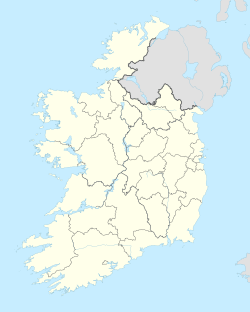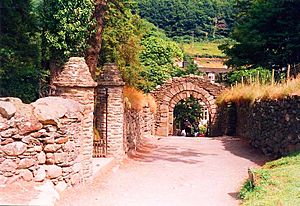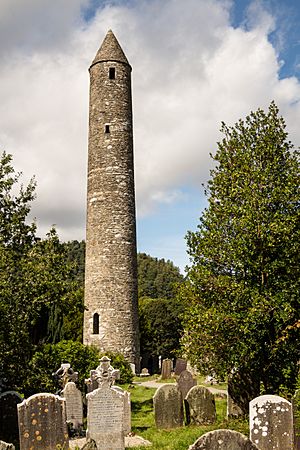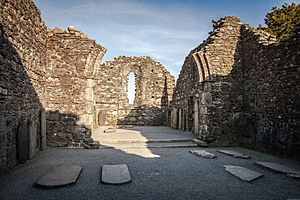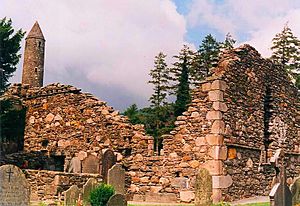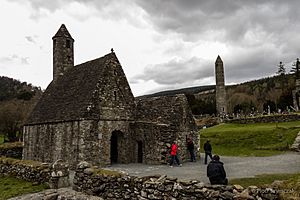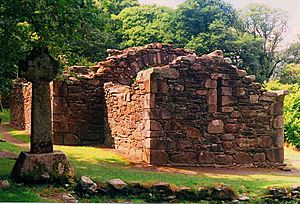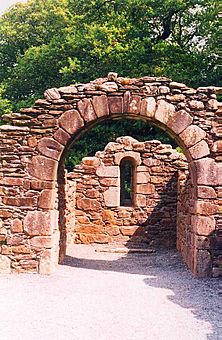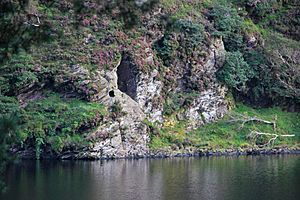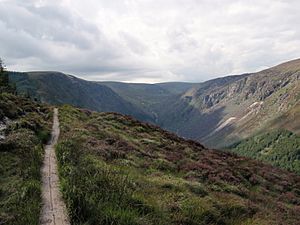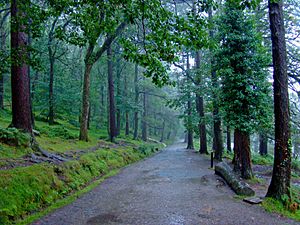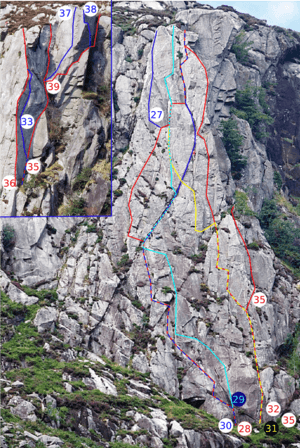Glendalough facts for kids
| Gleann Dá Loch | |
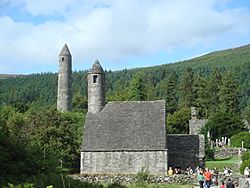 |
|
| Monastery information | |
|---|---|
| Order | Celtic Christianity |
| Established | 6th century |
| Disestablished | 1398 |
| Diocese | Glendalough (to 1185) Dublin and Glendalough (1185–1398) |
| People | |
| Founder(s) | Saint Kevin |
| Architecture | |
| Status | Inactive |
| Style | Irish monastic, Romanesque |
| Site | |
| Location | County Wicklow |
| Coordinates | 53°00′37″N 6°19′39″W / 53.01028°N 6.32750°W |
| Visible remains | Round tower, gateway, cathedral, several churches |
| Public access | yes |
Glendalough (which means "Valley of two lakes" in Irish) is a beautiful valley in County Wicklow, Ireland. It's famous for an old monastery that was built way back in the 6th century by Saint Kevin.
For many years, from 1825 to 1957, there was a lead mine in the Glendalough Valley. Today, Glendalough is a popular spot for people to visit. You can have picnics, walk on many different trails, and even go rock-climbing!
Contents
The Story of Glendalough's Past
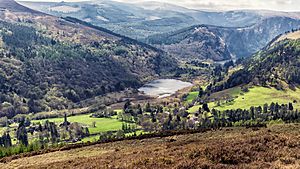
Saint Kevin was born into an important family in Leinster, a part of Ireland. When he was a boy, he studied with three holy men. During this time, he visited Glendalough. He later returned with a small group of monks to start a monastery where two rivers met.
Kevin wrote about fighting "knights" at Glendalough. Today, experts think he was talking about his own struggles and temptations, not actual battles. His reputation as a holy man grew, and many people followed him. He passed away around the year 618.
For the next 600 years, Glendalough became a very important place. Old Irish records often mention the deaths of its abbots (leaders of the monastery) and attacks on the settlement.
Around 1042, oak wood from Glendalough was used to build a very long Viking ship. This ship was about 30 meters long! A modern copy of this ship was built in 2004 and is now in Denmark.
In 1111, Glendalough was chosen as one of the two main church areas (called dioceses) in North Leinster. An important book, The Book of Glendalough, was written there around 1131.
Saint Laurence O'Toole, who was born in 1128, became the Abbot of Glendalough. He was known for being very holy and welcoming to visitors. Even after he became the Archbishop of Dublin in 1162, he would sometimes return to Glendalough for quiet time in a place called St. Kevin's Bed. He died in France in 1180.
In 1176, records say that Glendalough was "plundered by foreigners." Then, in 1214, the church areas of Glendalough and Dublin were joined together. After this, Glendalough became less important. English forces destroyed the settlement in 1398, leaving it in ruins. However, it still remained a local church and a place where people went on pilgrimage (a special journey for religious reasons).
Old maps from the 1500s show Glendalough. In the 1700s and 1800s, people described big, lively gatherings on St. Kevin's feast day, June 3rd.
The buildings you see at Glendalough today are only a small part of what it once was. In its busiest times, the monastery had workshops, places for writing books, guest houses, a hospital, farm buildings, and homes for both monks and many other people. The buildings that are still standing today were likely built between the 900s and 1100s.
Amazing Buildings and Monuments
The Gateway
The Gateway to Glendalough's monastic city is very special and unique in Ireland. It used to have two floors and two beautiful granite arches. The walls sticking out at each end suggest it had a wooden roof. Inside the gateway, there's a stone with a cross carved into it. This cross marked the boundary of a safe area, a place of refuge. Some of the original stone path inside the monastic city is still there, but most of the outer wall is gone.
The Round Tower
This impressive tower is made of a type of stone called mica-slate, with granite mixed in. It stands about 30 meters (almost 100 feet) tall! The entrance is 3.5 meters (about 11.5 feet) from the ground. The cone-shaped roof was rebuilt in 1876 using the original stones.
The tower originally had six wooden floors, connected by ladders. The four floors above the entrance each have a small window. The very top floor has four windows that face the main compass points (north, south, east, west). Round towers were built as bell towers and helped visitors find their way. They were also sometimes used as storage places or as safe spots during attacks.
St. Peter and St. Paul's Cathedral
St. Peter and St. Paul's Cathedral is the biggest building at Glendalough. It was built in several stages. The earliest part is the main hall (called the nave). The large mica-schist stones used up to the height of the west doorway were actually reused from an older, smaller church.
The back part of the church (the chancel) and the room where church items are kept (the sacristy) were added in the late 1100s and early 1200s. The arch leading to the chancel and the east window were beautifully decorated, though some of the stones are now missing. A doorway on the north side of the nave also dates from this time. Under the southern window of the chancel, there's a wall cupboard and a basin used for washing sacred items. A few meters south of the cathedral, you'll find an old cross made of local granite, known as St. Kevin's Cross.
Priests' House
The Priests' House has been almost completely rebuilt using its original stones, based on a drawing from 1779. It's a small building with a decorative arch at the east end. It got its name because priests were buried there in the 1700s and 1800s. No one knows for sure what its original purpose was, but it might have held special items (relics) belonging to St. Kevin.
St. Kevin's Church or "Kitchen"
This building has a stone roof. It originally had only a main hall (nave), with an entrance at the west end and a small round window in the east wall. The top part of this window can be seen above where the chancel arch was later added. The steep roof, made of overlapping stones, is held up by a curved ceiling inside. You could get to the room above the ceiling through a rectangular opening. The church also had a wooden second floor.
A small bell tower with a cone-shaped top and four small windows rises from the west end of the stone roof. It looks like a tiny round tower. People often call it St. Kevin's Kitchen because the bell tower looks like a chimney. But no food was ever cooked here!
St. Ciarán's Church
The remains of this church, which had a nave and a chancel, were found in 1875. This church probably honors St. Ciarán, who founded Clonmacnoise. Clonmacnoise was another monastery that had connections with Glendalough in the 900s.
St. Mary's or Our Lady's Church
This is one of the oldest and best-built churches. St. Mary's Church has a nave and a chancel that was added later. Its granite west doorway has slanted sides and a huge stone lintel (the beam above the doorway). The underside of the lintel has an unusual x-shaped cross carved into it. The east window is round-headed, with a decorative molding and two very worn carved heads on the outside.
Trinity Church
Trinity Church is a simple church with a nave and a chancel, and a beautiful chancel arch. It's located right next to the main road. A square doorway in the west wall leads into a later addition, possibly a sacristy. A round tower or bell tower was built over a vaulted room in this addition. This tower fell during a storm in 1818. The doorway added to the south wall of the nave also dates from this time. Stones sticking out from the gables (the triangular parts of the wall under the roof) would have supported the wooden beams of the roof.
St. Saviour's Church
St. Saviour's is the newest of the Glendalough churches, built in the 1100s. It was probably built when St. Laurence O'Toole was active. The nave and chancel, with their beautifully decorated stones, were restored in the 1870s using stones found at the site. The Romanesque chancel arch has three layers of carvings, with very fancy tops on the columns. The east window has two round-headed openings. Its decorated features include a snake, a lion, and two birds holding a human head in their beaks. A staircase in the eastern wall, leading from a nearby building, would have given access to a room above the chancel.
Monuments Near the Upper Lake
Reefert Church
This church, with a nave and chancel, dates from around 1100 and is located in a group of trees. Most of the walls around it are modern. The name Reefert comes from Righ Fearta, which means "the burial place of the kings." The church is built in a simple style. It has a granite doorway with slanted sides and a flat top, and a granite chancel arch. Stones sticking out from each gable supported the wooden beams for the roof. East of the church, there are two interesting crosses, one with a fancy woven pattern. Across the Poulanass River, near Reefert, are the remains of another small church.
St. Kevin's Cell
Built on a rocky point overlooking the lake, this stone structure was 3.6 meters (about 12 feet) across, with walls 0.9 meters (about 3 feet) thick. It had a doorway on the east side. Only the foundations are left today. It's possible that the cell had a stone roof that curved inwards, similar to the beehive huts on Skellig Michael in County Kerry.
St. Kevin's Bed
St. Kevin's Bed is a cave in the rock face, about 8 meters (26 feet) above the Upper Lake on its south side. The tall cliffs of The Spinc are above it. People say it was a quiet place for St. Kevin to retreat, and later for St. Laurence O'Toole. It's partly man-made and goes back 2 meters (about 6.5 feet) into the rock.
The "Caher"
This circular stone-walled area is on the flat ground between the two lakes. It's 20 meters (about 65 feet) across, and no one knows exactly when it was built. Nearby, there are several crosses, which were likely used as stops along the pilgrim's route.
Temple-na-Skellig
This small rectangular church is on the southern shore of the Upper Lake. You can only reach it by boat, then by climbing a series of steps from the landing spot. West of the church is a raised area with stone walls, where dwelling huts probably stood. The church, partly rebuilt in the 1100s, has a granite doorway with slanted sides. At the east end, there's a carved Latin Cross, along with several plain grave slabs and three small crosses.
The Miner's Village
Camaderry Mountain, which is 699 meters (2,293 feet) high and overlooks the upper Glendalough lake from the north, has a special mineral vein called the Luganure mineral vein. This vein is a source of lead in the form of galena (which is lead sulfide), and it also contains small amounts of silver.
While the main Camaderry mines were in the nearby Glendasan Valley, a second Miner's Village and processing area were built at the head of the Glendalough valley. The miners nicknamed this area Van Diemen's Land.
In 1859, the Glendasan and Glendalough mines were connected by a series of tunnels called adits, which are now mostly filled with water. These tunnels helped drain the mineral vein and made it easier to move the ore (rock containing minerals) to Glendalough, where it could be processed more easily. You can still see the rusty remains of machines that crushed the ore at the Miner's Village, but the old tramway and inclined rail system are gone.
Mining in Glendalough and Glendasan happened in three main periods. The first was from 1825 to 1890 by the Mining Company of Ireland. A second period took place between 1890 and 1925 by the local Wynne family. The mines were opened again briefly from 1948 to 1957, after which mining stopped completely.
Nature and Wildlife
Geography
The Glendalough valley was shaped during the last ice age by a huge sheet of ice called a glacier. This glacier left a pile of rock and dirt (a moraine) across the valley's entrance. The Poulanass River, which flows into the valley from the south through the Poulanass Waterfall, created a delta (a fan-shaped landform). This delta eventually split the original lake into two separate lakes.
Surrounding Glendalough are the mountains of Camaderry (699 meters or 2,293 feet), the hydroelectric power station at Turlough Hill (681 meters or 2,234 feet), and the large mountain mass of Conavalla (734 meters or 2,408 feet), which stands at the head of the valley. You can also see the peaks of Lugduff (652 meters or 2,139 feet) and Mullacor (661 meters or 2,169 feet).
Vegetation
Glendalough is surrounded by natural oak woodlands. Much of this wood was once cut regularly (a method called coppicing) to produce wood, charcoal, and bark. In springtime, the floor of the oakwood is covered with beautiful bluebells, wood sorrel, and wood anemones. Other common plants include woodrush, bracken, polypody fern, and various types of mosses. The lower layer of plants mostly consists of holly, hazel, and mountain ash.
Wildlife
Glendalough is a great place to spot some of Ireland's newer breeding birds, like the goosander and the great spotted woodpecker. You might also see some rarer birds, such as the common redstart and the wood warbler. Other birds you can often see include peregrines, dippers, common cuckoos, jays, and buzzards.
Fun Things to Do
Walking Trails
There are nine marked walking trails around Glendalough, with different levels of difficulty. These trails are looked after by the Wicklow Mountains National Park, which also provides a map of all the trails. Some trails stay on mostly flat paths around the two lakes of Glendalough, like The Miner's Road Walk and Green Road Walk. Others lead up to the Poulanass Waterfall area, with options to explore a network of forest paths, such as the Derrybawn Woodland Trail.
The most famous trails involve a steep path with about 600 steps (made from old railway sleepers). This path goes from the Poulanass Waterfall up to a viewpoint called The Spinc (from the Irish "An Spinc," meaning "pointed hill"). From here, you can see amazing views of the upper lake and the Glendalough valley below.
The most popular Spinc trail is the White Route. It follows another scenic boarded path westwards along the cliffs of the upper lake to the Glenealo Valley, where herds of red deer live. Then it goes down on stone paths to the Miner's Village and back along the Miner's Road on the north shore of the upper lake, ending at the upper lake car park. Since the entire White Route loop is on paths (either stone/sand paths or boarded railway sleepers), you can complete it in running shoes; you don't need special climbing footwear. The whole 9-kilometer (about 5.6 miles) loop of the White Route, starting and ending at the upper lake car park, takes about 2 to 3 hours.
The Wicklow Way, which is a very long marked walking trail, also passes through Glendalough.
There's also a 30-kilometer (about 18.6 miles) medieval pilgrimage trail called Saint Kevin's Way, which starts in Hollywood and ends in Glendalough.
Rock Climbing
Glendalough has south-facing granite cliffs located on the slopes of Camaderry above the north-western end of the valley, just above the Miner's Village. These cliffs have been a popular rock-climbing spot since 1948. The north-facing cliffs on the other side of the upper lake are not suitable for climbing.
The 2009 climbing guide for Wicklow lists about 144 climbing routes at Glendalough, covering all difficulty levels. The cliffs are especially known for their long routes that require multiple rope lengths to complete.
The climbs can be between one and four "pitches" (sections of climbing between belay points) and can be over 100 meters (328 feet) long. There are several climbing areas:
- Twin Buttress, located at the far western end of the cliffs overlooking the Miner's Village. It's a large rock face divided by a waterfall that sometimes splits into two streams. The most popular climbs are on West Buttress, Expectancy Slab, and Main Face.
- The Upper Cliffs, which are a band of cliffs high up on the hillside east of Twin Buttress.
- Acorn Buttress, a smaller rock face just below Twin Buttress, which is a popular spot for climbers to set up their base camp.
- Hobnail Buttress, a small rock face with some easier climbs, located about one kilometer to the east on the hillside.
The Irish Mountaineering Club has had a climbing hut here since the 1950s.
Below the cliffs, there's a large area with many big rocks, which is also used for bouldering (climbing on large rocks without ropes, usually close to the ground).
Gallery
-
St. Kevin's Church on the coat of arms of County Wicklow
Images for kids
See also
 In Spanish: Glendalough para niños
In Spanish: Glendalough para niños


